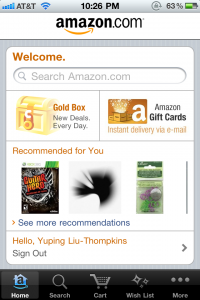With Verizon finally carrying iPhone and iPad and mass merchandisers such as Walmart selling smartphones on the cheap, the number of smart phones and mobile devices is bound to soar. This presents loyalty marketers a great additional touch point with their customers through mobile apps. What functionality should a marketer pack in a mobile app? To answer this question, in this blog, I’d like to take a look at different uses of mobile apps that have appeared in the marketplace.
Mobile Transaction Platform

Major retailers such as Amazon.com and eBay have developed their mobile apps that allow consumers to buy products directly from within the app. Compared with a mobile commerce website, these apps tend to be more user-friendly and incorporate the touch and swipe capabilities of smartphones for easier manipulation of product pictures, smoother transition between pages, and overall faster shopping experience.
Point-of-Sales Integration

Short of offering full mobile transaction capabilities, another type of app tries to mesh the mobile device with POS transactions in the physical world. A great example is the Starbucks Card Mobile app. Having registered a card in the app, a Starbucks card holder can use the app to pay for purchases at 6800 Starbucks stores in the US and additional locations in the Target store. The store POS system scans a barcode displayed in the app instead of a physical Starbucks card. Of course, this type of app requires equipment compatibility at offline locations, which can require costly investment. Continue reading “Loyalty Mobile Apps”
